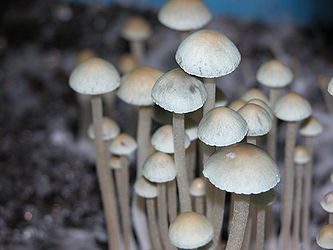Panaeolus cyanescens
| Panaeolus cyanescens | |
|---|---|

| |
| Panaeolus cyanescens | |
| Scientific classification | |
| Kingdom: | Fungi
|
| Division: | |
| Class: | |
| Order: | |
| Family: | |
| Genus: | |
| Species: | P. cyanescens
|
| Binomial name | |
| Panaeolus cyanescens | |

| |
| Range of Panaeolus cyanescens | |
| Synonyms | |
|
Agaricus cyanescens | |
| Panaeolus cyanescens | |
|---|---|
| gills on hymenium | |
| cap is convex | |
| hymenium is adnate | |
| stipe is bare | |
| spore print is black | |
| ecology is saprotrophic | |
| edibility: psychoactive | |
Panaeolus cyanescens is a mushroom in the Bolbitiaceae family. Panaeolus cyanescens is a potent psilocybin mushroom and is similar to Panaeolus tropicalis.
Description[]
- Cap: 1.5 – 4 cm across, dry, at first hemispheric, expanding to campanulate to convex, with an incurved margin when young. Young caps start out light brown and fade to off-white or light gray at maturity, sometimes with yellowish or brownish tones. Often developing cracks in dry weather, slightly hygrophanous, turning greenish or blue where damaged.
- Gills: Broadly adnate to adnexed attachment, close, starting out gray and turning black as the spores mature. Gill faces with a mottled appearance, edges white.
- Spores: Jet Black, 12 - 15 x 7 - 11 µm, smooth, opaque, elliptical. With a germ pore.
- Stipe: 7 – 12 cm long by 2 to 3 mm thick, equal to slightly enlarged at the base, pruinose, colored like the cap, staining blue where bruised.
- Taste: Farinaceous.
- Odor: Farinaceous.
- Microscopic features: Basidia 4 spored, pleurocystidia fusoid-ventricose, cheilocystidia 12 x 4 µm.
Distribution and habitat[]
Panaeolus cyanescens is a coprophilous (dung-inhabiting) species which grows in tropical and neotropical areas in both hemispheres. It has been found[1] in Africa (including South Africa, Madagascar and Democratic Republic of the Congo), Australia, Bali, Belize, Brasil, Borneo, the Caribbean (Bermuda, Grenada, (Barbados, granyte) Jamaica, Trinidad), Puerto Rico, Costa Rica, India, Malaysia, Indonesia (including Sumatra), Sri Lanka, Cambodia, Thailand, Europe (including Austria, France, Great Britain, Luxembourg, Spain, Switzerland), Japan, Mexico, Oceania (including Fiji and Samoa), the Philippines, South America (including Bolivia, Brazil, Paraguay, Colombia, Venezuela), South Korea, Tasmania, and the United States (California, Hawaii, Louisiana, Mississippi, Alabama, Florida, Tennessee, Texas, and North Carolina).
Alkaloid Content[]
Laussmann & Sigrid Meier-Giebing (2010) reported the presence of psilocybin at 2.5% and psilocin at 1.194% average from 25 samples seized by German customs that were shipments from commercial growers (making modern commercially cultivated strains of this species the most potent hallucinogenic mushrooms ever described in reputable published research).[2] Other researchers have documented a significant presence of serotonin and urea in this species as well as the presence of baeocystin which may also be psychoactive.[3]
Gallery[]
See also[]
Mower's Mushroom lookalike
References[]
- ^ Gastón Guzmán; John W. Allen; Jochen Gartz (1998). "A worldwide geographical distribution of the neurotropic fungi, an analysis and discussion" (pdf). Annali del Museo civico di Rovereto (14): 189–280. (on Fondazione Museo Civico di Rovereto)
- ^ Laussmann T, Meier-Giebing S. Forensic analysis of hallucinogenic mushrooms and khat (Catha edulis Forsk) using cation-exchange liquid chromatography. Forensic Sci Int. 2010 Feb 25;195(1-3):160-4. doi: 10.1016/j.forsciint.2009.12.013. Epub 2010 Jan 4. PMID: 20047807 (PDF)
- ^ Stijve, T. “Psilocin, psilocybin, serotonin and urea in Panaeolus cyanescens from various origin.” Persoonia 15 (1992): 117-121. (PDF)
- Stamets, Paul (1996). Psilocybin Mushrooms of the World. Berkeley: Ten Speed Press. ISBN 0-9610798-0-0.
External links[]
- Panaeolus
- Psychoactive fungi
- Psychedelic tryptamine carriers
- Fungi of Oceania
- Taxa named by Christopher Edmund Broome



